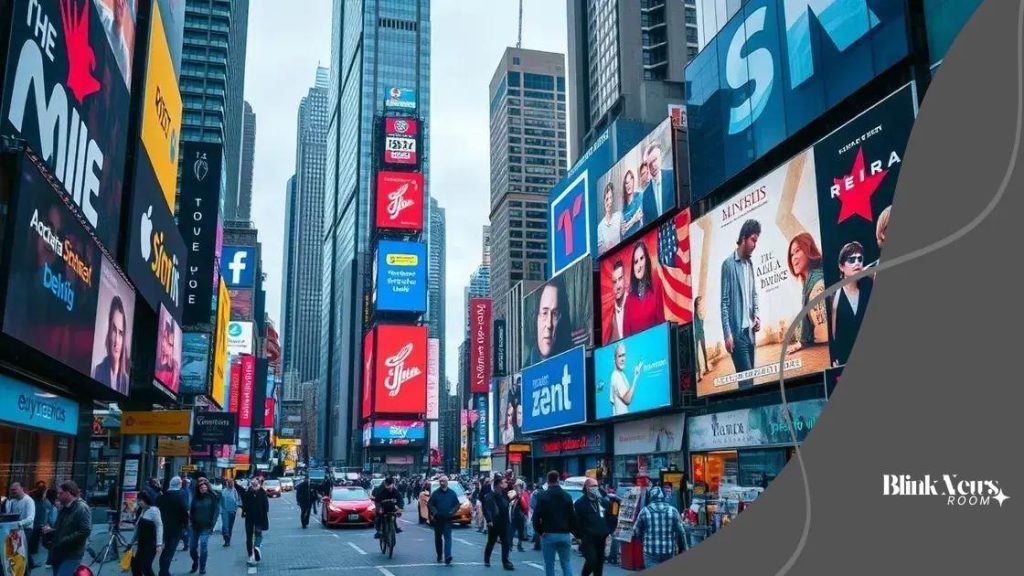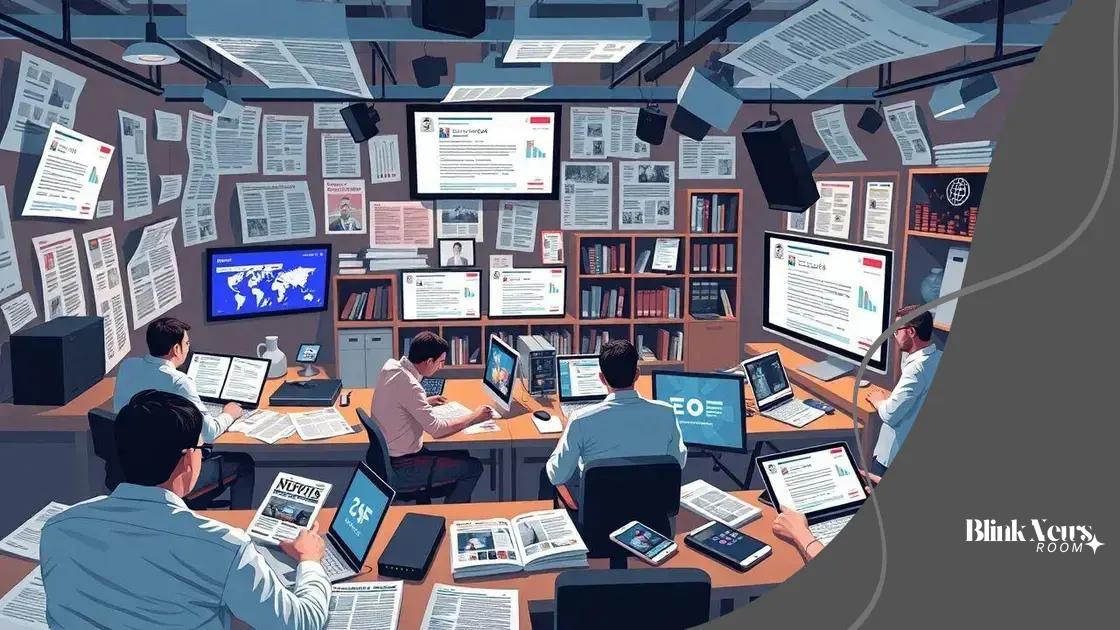Media industry shifts: understanding the changing landscape

Anúncios
Future predictions for the media industry highlight the significant impact of technology, changing consumer preferences, and the necessity for creativity to engage audiences effectively with personalized and immersive content.
Media industry shifts are reshaping our daily interactions with information and entertainment. Have you noticed how your favorite news source has changed lately? In this article, we’ll explore the latest developments and what they mean for you.
Anúncios
Emerging trends in media consumption
As we delve into the emerging trends in media consumption, it’s important to recognize how technology is continuously reshaping our viewing habits. With more people consuming content on various devices, understanding these shifts can help us adapt to new opportunities in the media landscape.
The Rise of Streaming Services
Streaming platforms are leading the charge in changing how audiences access entertainment. Services like Netflix and Hulu allow viewers to watch what they want, when they want. This flexibility has transformed the traditional viewing experience.
Key Features of Streaming Services
- On-demand viewing for personalized experiences
- Exclusive content that attracts new subscribers
- User-friendly interfaces for easier navigation
As this surge in streaming continues, traditional media outlets face incredible pressure to innovate. Many are now experimenting with online formats, showcasing live events, and integrating social media to enhance viewer engagement.
Anúncios
Additionally, mobile consumption is skyrocketing, especially among younger audiences. More individuals are engaging with content on their smartphones, leading to a greater demand for adaptable and bite-sized media formats. This trend is evident in how social media platforms like TikTok and Instagram are becoming significant players in the media industry.
The accessibility of smartphones allows users to connect with news, entertainment, and educational content in real time, influencing how they perceive and interact with information.
Impact of Social Media on Consumption
Social media not only influences how we consume media but also shapes what we consume. Users often rely on their feeds to discover trending content, making it crucial for media producers to stay relevant and engaging.
- Real-time updates on current events
- Viral trends that can shift viewer interest
- Interactive content that encourages engagement
This dynamic shift in consumption patterns signifies a pivotal moment in our relationship with media. As audiences become accustomed to evolving technologies, staying informed about these emerging trends is essential for media creators and consumers alike.
The role of technology in media evolution
Technology plays a crucial role in shaping the media evolution we experience today. Innovations are transforming how content is created, distributed, and consumed, impacting our daily lives.
Innovations Driving Change
The rise of high-speed internet has revolutionized media access. Now, audiences can watch videos, listen to podcasts, and read articles instantly. This accessibility has made information more abundant than ever.
Key Technologies Influencing Media
- Artificial intelligence for personalized recommendations
- Virtual reality to enhance storytelling experiences
- Data analytics for understanding audience preferences
The introduction of social media platforms has also altered how we consume content. Users can share their opinions and engage with creators directly, creating a two-way interaction. This interaction shifts the balance of power from media companies to the audience.
As new devices emerge, such as smart speakers and wearables, they are changing the landscape even further. These devices allow users to access content in novel ways, integrating media consumption seamlessly into their daily routines.
Impact on Traditional Media
Traditional media outlets are adapting to these tech advancements to stay relevant. Many have embraced digital platforms, providing online news content, podcasts, and streaming services to attract new audiences.
- Shifting focus from print to digital formats
- Incorporating interactive elements in news reporting
- Utilizing social media for audience engagement
As a result, the relationship between technology and media will continue to evolve. Understanding these changes empowers creators and consumers alike to navigate this dynamic landscape effectively.
Impact of social media on traditional outlets

The impact of social media on traditional outlets has been profound and far-reaching. As social media platforms grow, they change how audiences consume news and entertainment. This shift requires traditional media to adapt quickly to the new landscape.
Changes in News Consumption
More people are turning to social media for news instead of traditional sources like newspapers and television. Platforms such as Facebook and Twitter allow users to access real-time updates, leading to a significant decline in print media subscriptions.
Key Effects of Social Media on Traditional Media
- Immediate access to breaking news
- Greater audience engagement through comments and shares
- Increased competition for attention
This competition pressures traditional media outlets to deliver content more rapidly and engage audiences on platforms they frequent. Many outlets are now creating profiles on social media to interact with their audience directly.
As these outlets embrace social media, they also face challenges. Misinformation can spread easily and rapidly. Traditional media must verify facts and enhance their credibility to maintain trust with audiences.
Strategies Employed by Traditional Outlets
To thrive in this new environment, many traditional media outlets are adopting various strategies. They focus on creating high-quality content that encourages sharing and engagement. Additionally, they are integrating visual storytelling into their reporting to attract more viewers.
- Utilizing multimedia content like videos and infographics
- Engaging audiences through polls and Q&A sessions
- Partnering with influencers to broaden reach
By moving toward a digital-first approach, traditional media can reach broader audiences and remain relevant in an increasingly competitive media landscape.
Changing advertising strategies in the media
As the landscape of media evolves, changing advertising strategies become essential for businesses trying to connect with their audiences. With more consumers spending time on digital platforms, traditional advertising methods are not as effective as they once were.
Shift to Digital Platforms
Many companies are moving their advertising budgets from TV and print to online platforms. This shift allows them to target specific demographics more effectively, reaching potential customers where they spend their time.
Key Elements of Modern Advertising
- Targeted ads based on user data
- Content marketing to provide value and engage
- Social media advertising for interaction and reach
Additionally, advertisers are increasingly utilizing influencers to promote their products. Influencer marketing allows brands to tap into the loyalty and trust that influencers have built with their followers. Brands can create authentic connections with their audience by partnering with the right personalities.
Furthermore, the rise of mobile advertising cannot be ignored. Consumers are constantly on their smartphones, making mobile-friendly ads crucial. Brands must ensure that their ads are optimized for mobile devices to capture the attention of on-the-go consumers.
Emphasis on Creative Content
Alongside targeting and platform choice, creativity plays a key role in successful advertising. Unique and engaging campaigns tend to stand out in a crowded market. For instance, brands that utilize storytelling in their ads can forge a deeper emotional connection with their audience.
- Using video content to tell a story
- Creating interactive advertisements for user engagement
- Leveraging user-generated content for authenticity
By staying on top of these changing advertising strategies, brands can maintain relevance and connect with their audiences effectively. As technology and consumer behavior continue to evolve, so too must the strategies brands use to communicate their messages.
Future predictions for the media industry
Future predictions for the media industry suggest a dramatic transformation in how content is created and consumed. As technology continues to evolve, media practices will likely adapt to new consumer behaviors and preferences.
Technological Innovations on the Horizon
Emerging technologies, such as artificial intelligence and augmented reality, are set to reshape media experiences. AI can help tailor content to individual preferences, making the consumption experience more personalized.
Key Predictions for Media Evolution
- Wider adoption of immersive content experiences
- Increased use of data analytics for audience targeting
- Growth of subscription-based models over traditional advertising
Moreover, as audiences seek more interactive experiences, we can expect a rise in video content and podcasts. These formats engage users more actively, making them an essential part of future media strategies.
Social media platforms will also continue to play a significant role in content distribution. The integration of e-commerce with social media will allow brands to sell directly to consumers through content, blurring the lines between advertising and entertainment.
Changing Consumer Expectations
As consumers become more digitally literate, their expectations for content quality and accessibility will rise. Media companies will need to prioritize transparency and authenticity to build trust with their audience.
- Higher demand for local and diverse content
- Focus on sustainability and ethical practices
- Greater emphasis on community engagement
As the landscape continues to shift, content creators will need to innovate constantly. Staying ahead of trends will enable them to maintain relevance and foster meaningful connections with their audience.
In conclusion, the future of the media industry will be shaped by rapid technological advancements and changing consumer preferences. Embracing new technologies like AI and augmented reality will help media companies create more engaging experiences. As audiences demand personalized content and transparency, adapting to these evolving needs is critical for maintaining relevance. Staying ahead of trends will not only enhance connections with audiences but also push the boundaries of creativity within the industry.
FAQ – Questions about the Future of the Media Industry
What technological innovations will shape the future of media?
Technological innovations like artificial intelligence and augmented reality will create more engaging and personalized content for consumers.
How are consumer preferences changing in the media industry?
Consumers are increasingly seeking personalized, diverse, and ethical content that aligns with their interests and values.
What role will social media play in the future of media?
Social media will continue to be a major platform for content distribution and audience engagement, integrating commerce with entertainment.
Why is creativity important in future media strategies?
Creativity will help brands stand out in a crowded market, allowing them to connect emotionally with their audience through unique storytelling.